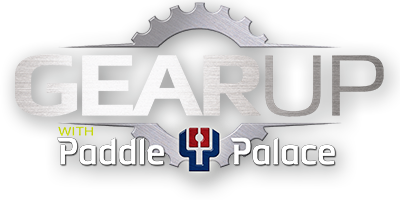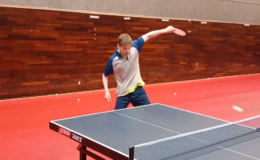By Larry Hodges, USATT Hall of Famer and Certified National Coach
There is nothing more infuriating than losing to a patient chopper who lets you beat yourself with your own errors. Losing to a chopper is like four-putting in golf; you may have made some good drives to get to the green, but all you remember are the misses at the end. Rather than four-putting forever, let’s learn how to beat the chopper.
A chopper is weakest in the middle, and that is where you should focus most of your attack. However, you have more table (and so more margin for error) by going diagonally to a corner. Going for a winner down the line often catches the chopper by surprise. A chopper who is not particularly fast is vulnerable at the corners, especially if you aim one way and then go the other; a chopper with inverted on both sides is more vulnerable in the middle. Keep these “basics” in mind when playing any of the following styles.
There are four general ways of playing a chopper. Informally they are called European style, Asian style, Pick-hitting, and Chiseling. While you should favor one of these styles, feel free to combine them in developing your own style against choppers.
In all four cases, focus on attacking the middle, the weakest spot for nearly all choppers. This is imperative when playing choppers.
European Style. The goal here is to bring the chopper in close to the table, and then attack hard, especially at the chopper’s middle. The chopper is too close to the table to make the return, and so misses. When using this technique, you should mostly serve short to bring the chopper in, and try to follow with a strong attack. Sometimes, however, fake the attack, and push short instead – the chopper, in his haste to back up for the expected attack, will have trouble with this ball, and will often have to make a last-second lunge to return it. Even if he makes the return (often a weak one), he will be left jammed over the table and vulnerable to the next ball, which you can promptly loop for a winner. If the chopper stays closer to the table to guard against this drop shot, then you attack. The chopper has absolutely no way of answering this … in theory.
During a rally, if the chopper makes a good return from away from the table, push short again, and start over. The object in a rally is to catch the chopper too far away from the table or moving backward so that you can drop the ball short, force him to rush in, and attack when he’s jammed up against the table. Alternatively, you can push a few balls, keeping the chopper close to the table, and then attack when you think he’s not expecting it.
Asian Style. The goal here is to control the spin and pace of the rally. This method is especially good against a long-pipped chopper, but takes regular practice against a chopper to learn to do effectively. Pips-out players are especially good at this style, but many good inverted players also play this way. This style doesn’t work well against an all-inverted chopper who chops very heavy. Let’s assume you are playing a long-pipped chopper.
Here the aim is to get the chopper off the table, and then attack relatively softly over and over, into the long pips side, but not with full spin. The chopper can only return whatever spin you give him because of the long pips, and so their returns are not particularly heavy, making your continuous soft attack easy. After topspinning a few balls, you find one you like and loop or smash a winner.
Depending on what you are more comfortable with, you can topspin many balls in a row before going for a winner, or only a few – be unpredictable. Mix in pushes. Some players just topspin over and over, not pushing or going for a winner unless they get a very easy one. You should try to vary your spin, sometimes looping very dead, sometimes spinny. However, beware of varying spin returns when you vary your own spin. For example, when you give heavy topspin, expect heavy chop, and so either lift the ball more on next shot, or push and start over. Don’t fall into the trap of spinning heavily over and over – a chopper loves it, and all you’ll get are heavy chop returns, which can be very difficult to loop consistently.
You can mix in pushing, but too much pushing will throw your own timing off. By topspinning over and over to the long pips side (but not with full spin), you can build up a rhythm that a chopper will have difficulty breaking.
Try to get down to almost eye level with the ball by bending your knees. This will help your consistency by making the lifting easier and will get your eyes closer to the ball so you see it better.
Pick-hitting Style. The goal here is to pick your shots against the chopper’s push, and if you can’t easily put away the return, push and patiently look for another ball to attack. Unless you have a put-away shot, you rarely attack two balls in a row. Instead it’s push a few balls, attack, push a few balls, attack, push a few balls, attack, etc., until you get a putaway shot or the chopper misses. Most of the attacks should go to the chopper’s weakest spot, usually the middle, sometimes the forehand. (The backhand chop, often with long pips, is usually a chopper’s most consistent shot, but not always.) Most players attack by forehand looping, but you can also drive or smash, forehand or backhand.
You need to vary your pushes to find a ball to attack. For example, a quick, off-the-bounce push to a chopper’s long pips often forces a weak return, and any push with long pips has little spin, which you may be able to attack. A sudden push to the forehand can set up your own forehand attack. After a series of heavier pushes, a sudden no-spin or light backspin push can set up a higher return to attack.
The advantage of this style is you don’t have to deal with varying chop returns, which are where attackers make most of their mistakes. The disadvantage – besides the obvious patience needed and long rallies that you’ll sometimes play – is that the chopper may start attacking. You have to find a balance. The more the chopper attacks effectively, the more you’ll need to attack to stop that.
Chiseling Style. I am not fond of this style. This basically means pushing with the chopper until the chopper either misses, pops up an easy one, or gets impatient and attacks too much. At the higher levels, chiseling is rare, but at the lower and medium levels, it is more common. Since I’m a strong believer that the game has to be FUN (it is a game!), I don’t like this way of winning. Unless you’re a chopper yourself (in which case SOMEONE’s got to push, and it might as well be you), I’d rather see a player lose by attacking in some way. You may lose now, but you’ll learn how to play a chopper better in future matches.



